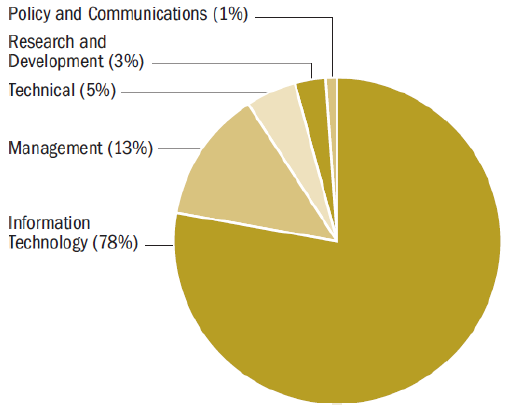For a full copy of The Sector’s report, please contact the firm.
Ontario’s Government is “adopting new “digital practices and technologies that will deliver simpler, faster, better services to Ontarian’s.” In the 2019 Budget, the Government revealed its digital plan that includes, among other measures, the Simpler, Faster, Better Services Act.” And as per the Government’s claims, “if passed, it will significantly improve how government works and the services it delivers to the people of Ontario” (Government of Ontario, 2019).
At the same time, the organizations which largely deliver, government social services in Ontario (often coined “The Third Sector”), are experiencing an acute “digital skills gap;” the majority of reporting they are not “confident about having enough skilled staff or training to effectively use their technology for their work” (ONN, 2019).
Also, at the same time, Canada’s “Big Four” consulting firms, have been investing-in and building internal capabilities to advise “public sector organizations at the forefront of using digital technologies to transform the way they function” (Deloitte, 2019).
Over the last twenty years, the Ontario Public Service “transitioned from being an organization which provided service-delivery directly to clients, to an organization which now focuses its core operations on policy and program design,” outsourcing it’s “service delivery” to the Third Sector (Government of Ontario, 2017). It currently spends approximately $350,000,000 annually on consultants focused on technological innovation, making little additional provision to ensure these capabilities are developed in the Third Sector. This dissertation tests the hypothesis:
If the Government of Ontario shift’s spending from consulting services in policy and program-design at the ministerial level, toward a greater proportion of spend, allocated toward management consulting services focused on digital transformation of service-delivery, at the agency and point-of-service level, it will yield a positive social return on investment.
Table of Contents
1. Introduction: The Undefined Role of the Ontario Public Service 8
1.1 Assumption 1: The Speed of Digital 10
1.2 Assumption 2: Consulting Firms Are the Required Intermediary 10
1.3 Hypothesis 11
1.4 The Approach: What if “The Big Four” were Retained? 11
1.5 The Problem Statement: The Third Sector Can’t Afford the Big Four 12
2. Context Behind the Hypothesis: Government Spending (A Market Analysis)
2.1 Government Spending on Transfer Payments: The Market for Social Services 12
2.2 Segmenting the Third Sector’s Transfer Payments 12
2.3 Government Expenditure on Consulting Services (The Market For…) 13
2.3.1 Government Buying “Technical” & Consulting Firms Selling “Technical”? 15
2.3.2 Costly Consultants Permanent Employees Could Do for Less 15 2.4 The Market for Consulting Service to the Third Sector 16
3. Literature Review: Existing Literature from All Three Sectors
3.1 Conducting the Literature Review 17
3.2 Broader-Public-Sector Literature on Government Transformation 17
3.2.1 The Creation of Streamlined Client Pathways 18
3.2.1.1 Government Literature on Streamlined Pathways 18
3.2.1.2 Third Sector Literature on Streamlined Pathways 19
3.2.1 Proven Outcomes & Tracked Evidence (Finance First) 20
3.2.2 Inter-Governmental Integration: Integration Before Digitization 20
3.2.3 Inter-Sectoral Integration: The Digital Requirement 20
3.3. The Big Four Literature on Digital Transformation of Government 20
3.3.1 The Preeminent Role of Digital in Government Transformation 21
3.3.1.1 A Tone of Urgency, Competition, & Optimism 22
3.3.3 Better Delivery Through Stronger Data 22
3.3.4 Self-Serve Models 22
3.4 Literature on the Third-Sector’s Skill Gap 22
3.4.1 The Sector’s Digital Skills Gap 22
3.4.2 A Lack of Internal Digital Capabilities 23
4. Research Methodology: An “Intrinsic” Case Study
4.1 Overall Approach: The Critical Success Factors to the Consulting Engagement 23 4.1.1 Research Questions: Breaking the Problem into Factors to Build Strategy 24 4.1.2 The Structure of the Research 26
4.1.3 Research Presentation Format 27
4.2 Research Plan 1: Factors For & Against, Digital Transformation; Third Sector Perspective
4.2.1 Description, Rationale and Expectations 28 4.3.1.1 The Survey (Questionnaire) 29 4.3.1.2 Semi-structured Interviews 29
4.3.2 Critique 29
4.3.2.1 The Survey (Questionnaire): The Sample Bias, Timing, and Reliability 29
4.3.2.2 Semi-Structured Interviews 30
4.3.3 Issues Encountered: The Good and the Bad 30
4.3.3.1 The Survey (Questionnaire) 30
4.3.3.2 Semi-Structured Interviews 30
4.3.4 Analyzing the Results 31
4.3.4.1 The Survey (Questionnaire) 31
4.3.4.2 Semi-structured Interviews 31
4.4 Research Plan 2: Providing Capacity Building Services; The Big Four’s Perspective
4.1.1 Description, Rationale, and Expectations 31
4.4.1.1 Semi Structured Interviews 31
4.4.1.2 Datamining for Verification and Fact Checking 32
4.4.2 Critique
4.4.2.1 Semi-Structured Interviews 32
4.4.2.2 Data Mining for Verification & Fact-Checking 33
4.4.3. Issues Encountered 33
4.4.3.1 Semi-Structured Interviews 33
4.4.4 Analyzing the Results 33
5. Findings
5.1 Analysis of Findings
5.1.1 Third Sector Perspective: Analyzing Survey Results and Interview Responses 33 5.1.2 Market Factors which Support Digital Transformation of Third-Sector Organizations
5.1.3 The Big Four’s Perspective: Analyzing Survey Results and Interview Responses 40
5.2 Learning Points Toward Strategic Government Spending 46
6. Proposed Strategic Government Spending
6.1 Diverting Funding from Program & Policy Design to Service Delivery 46
6.1.2 Provincial Transfer Payments to Create Scale and Efficiency 47
6.1.2.1 Creating Scale Through Operations Design 47
6.1.2.2 Creating Third Sector Scale Through Consolidation 47
6.1.2.3 Issuing Tenders for Management Consulting Services Toward Digital Transformation
7. Concluding Remarks
7.1 Dissertation Summary 48
7.2 Critique and Limitations 48
7.2.1 Lack of Technical Rigor 49
7.2.2 Lack of Formal Financial Analysis 49
7.3 Further Research 49
#fundraising #digitaltransformation #toronto #socialimpact #wbs #love #impactinvesting #sdgs #csr #esg





